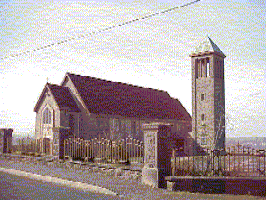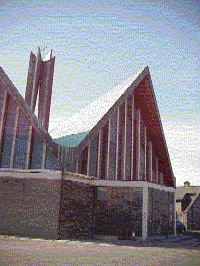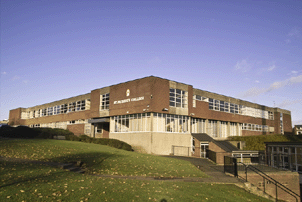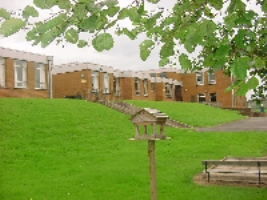History
The Parish expands and suffers, 1961-1980This year was the fifteen hundredth anniversary of the death of Saint Patrick and was accordingly proclaimed a Patrician Year. Celebrations were held in Dublin, and in our Diocese there were celebrations in Connor, Belfast and Down. In Connor the celebrations consisted of Pontifical High Mass offered by His Lordship Dr Kyne, Bishop of Meath. This was in the open air, on the side of Slemish, scene of Patrick’s boyhood captivity. The sermon was preached by Very Rev Cahal Daly, Queen’s University.
Huge crowds of people attended, so much so that the roads for miles around were choked by the unprecended traffic. In fact many people, including some of the visiting Prelates, were prevented from reaching the site until a very late hour.
On 5 June 1961 Father Liam Vaughan who had been ordained priest the previous day in Wexford, said his first Mass. He was the first student of St MacNissi’s College to be ordained.
A new six classroom girls’ primary school was opened and solemnly blessed by His Lordship Most Reverend Dr Mageean on 4 September 1961.
ST LOUIS PRIMARY
The catholic population had now risen to four thousand, five hundred. Extra Church accommodation was necessary. The decision was made to replace Crebilly Church with a new one and a site was kindly donated by the Kearney Family.
The new Church of St Patrick was blessed and opened by His Lordship Most Reverend Dr Mageean on 14 October 1961. The Stations of the Cross were in oils and painted by the well known Dominican artist, Father Buckley.
NEW CHURCH AT CREBILLY (St Patrick’s)
The year 1962 had a sad beginning with the death on 17 January of the Bishop. Doctor Mageean had ruled the Diocese wisely and well from 1929 until 1962, a very long period of office.
The same month parishioners were sad to learn of the untimely death of Father Louis Comerton who had been a curate in Ballymena.
On Saturday 10 June the announcement was made of the appointment of Most Reverend William Philbin, Bishop of Clonfert, to be Bishop of this Diocese.
In preparation for the opening of the General Council of the Vatican a Novena of Prayer was offered in the Parish from 27 September to 5 October. The opening of the Council was broadcast on Eurovision Television.
Cardinal D’Alton died towards the end of February. A public Requiem Mass was celebrated in All Saints’ by Canon McGrattan.
On Sunday 24 March in St Patrick’s Church, Crebilly the new and rather precious picture of Our Lady of Perpetual Succour was blest and dedicated. This picture had been donated by a parishioner, Mr Kieran McLaughlin who had recently returned from the Arctic circle where he worked as a technician in a USA defence project. On his next visit home Mr McLaughlin had the pleasure of seeing his gift in Crebilly Church before he was struck down by a rare and virulent kidney disease. He died within two weeks at his family home in Warden Street.
Fr Francis Teggart and Father Alex Darragh had been appointed to Ballymena in 1960 and their efforts had led to a resurgence of Youth Club activities in the Parish. They organised a Boxing Club for the younger boys. They also organised a Girls’ Club, as well as some mixed activities. A Choral and Drama Society staged the operas ‘Lilac Time’ in 1963 and ‘The Student Prince’ in 1964.
The year 1964 was a year of change in Ballymena. In March the Parish Priest, Canon McGrattan was created Archdeacon of the Diocese. To celebrate the event the Urban Council introduced for the first time in Ballymena:
the first pedestrian crossing
the first set of traffic lights
anyway, the three events happened in the one week!
The two events in 1965 with the most far reaching effects were:
the introduction of the use of vernacular in the Mass
the ending of the Second Vatican Council and the spreading of its Decrees
The use of English in the Mass started on 7 March 1965. Leaflets had been published about one month before. The priests of the Parish held practices so that the Mass was celebrated without confusion – the people answered in unison all the responses.
New housing estates were proposed for Harryville and it was decided to build a Church in that area. A site for a Church had been bequeathed to the parish in 1895 by a Miss McKeown. It had remained vacant for seventy years and during that time it was referred to by the townsfolk as the Chapel Field or Pope’s Plot. Work commenced on the site in September 1965. The construction method employed was steel framing on piled foundations. It is interesting to record that the Piling Contractors had to go to a depth of forty one feet before they struck rock.
In 1966 a new school for boys, All Saints’ Primary School, was blessed by Bishop Philbin on a new site close to St Patrick’s Intermediate School in Hugomont.
During the preparation of the site, near the Hugomont Mansion, the excavating machines uncovered an ancient underground chamber in a perfect state of preservation.
Photographs of the tunnel were taken before it was ordered by the Ministry of Education to be filled in.
Unfortunately the rumour which swept Ballymena that a treasure had been discovered had no basis in fact.
ALL SAINTS PRIMARY SCHOOL
Immediately the old school became vacant Dean McGrattan requested the Ministry of Education to allow the school to be used as a Youth Club. The Ministry agreed. Father Darragh moved in with a horde of youthful boxers; and with the boys doing the work and Father Darragh acting as Clerk of Works, they converted the disused school into a presentable club.
For reasons of security it was decided to demolish the old Church at Crebilly. This was done in the summer of 1967. Only the stonework at the four corners remained to mark the perimeter of the old building. Dean McGrattan had the floor space of the church macadamised, and a Calvary erected on the site of the former altar. (It was under the altar that Fr John Fitzsimons was buried in 1825).
During the demolition, in the heavily timbered roof there was found a board on which was written in a strong hand (probably with a carpenter’s pencil) the following:
James Cosbie, Builder; John T & H McAtamney, Architect; John Lynch, PP; Neal McCart, Sexton. 19 February 1879. Take notice that I, Hugh Wasson, of No 556 Ballykeel Loyal Orange Lodge, sheeted the roof of this Chapel with the help of James Mulvenna, Ballymena, Foreman; John Mulvenna, Ballymena; John Getty, Tyshan.
(This information would seem to indicate that the church, built in 1810 by Fr Fitzsimons, was re-roofed and repaired in 1879 by Fr Lynch, who also built All Saints’ Church and the Boys’ old school).
In 1967 and 1968 All Saints’ Boxing Club won every major Youth Club trophy in Ulster and came second in Ireland both years.
As the boxers vacated the Parochial Hall it was possible to start an Indoor Bowling Club.
Fr Kevin Donnelly continued with the activities of the Choral and Drama Society – who, in the Spring of each year presented an opera. The fact that it was fully booked out for each night of the week indicated its success.
The Church at Harryville, dedicated to Our Lady, Mother of the Church, was solemnly blessed and dedicated by His Lordship Most Reverend Dr Philbin on 8 September 1968. This Church is hexagonal in shape. It is surmounted by a graceful spire rising from an unusual copper-finished roof. In full sight of the altar, and with a striking glass partition, there is a sound-proof cry-room to accommodate mothers and small children. On the opposite side there is the choir annexe. Triangular shaped windows with tinted cathedral glass to give the maximum of light inside are installed whilst an engraved glass technique was employed in the design of the low level windows at each of the side entrances. Special emphasis in locating the Tabernacle on the rear wall was effected by the use of a triangular shaped back-cloth in white marble briquettes. An unusual technique, ceramic and steel mosaic pieces, was used for the triangular shaped Tabernacle and Baptismal Font. The Church can accommodate a congregation of one thousand and fifty people.
CHURCH OF OUR LADY, MOTHER OF THE CHURCH, HARRYVILLE
The first Mass in the new church was celebrated by Father Liam Vaughan who had been born in one of the houses on the Larne Road – opposite the church.
In the political life of the Six Counties 1969 will be remembered as a milestone. It began on New Year’s Day with the eventful march of the Civil Rights Association from Belfast, through Burntollet, to Derry. The climax came in August when dreadful rioting broke out in Belfast and Derry, culminating in the burning out of catholic families in Bombay Street, Belfast. There was also much shooting and bombing. Ballymena escaped the trouble.
The parish was highly honoured when in July came the announcement from Rome that the Holy Father had appointed Dean McGrattan to be Vicar General of the Diocese. This came with the honour of a Domestic Prelacy and the title of Monsignor. It was over sixty years since a former Parish Priest, Father Alex McMullan (PP from 1889 to 1908) was appointed Vicar General.
On 6 April Father Liam Blayney, Suffolk Street was ordained in Kiltegan and said Mass in All Saints’ the next day.
In June Father Aidan Kerr, Glenariffe Crescent was ordained for the Diocese and said Mass in All Saints’ the next day.
In July Father John Barrett was transferred to St John’s Belfast and was replaced by Father William McKeever, CC Kilkeel.
In 1969 the new Parochial House being built alongside the Church in Harryville was nearing completion and planning approval had been received to enlarge the car-park space.
The first Parish Bulletin was printed and distributed at all Masses.
The new housing estates built on the Harryville side of the town meant that the school at Crebilly was overcrowded. In 1971 the decision was made to replace it with a school more conveniently placed to the area where most of the children lived. In 1974 the oldest and first school in the parish closed and a new school, St Mary’s, opened on the Larne Road at Harryville with two hundred and sixty three pupils. It was a school for boys and girls.
Later, St Louis Girls and All Saints Boys also became co-educational schools.
No 5 Market Road, home of the McGarry family was purchased by Canon McGrattan and used by the Catholic Marriage Advisory Service.
In March 1970 Father MKeever moved into the new Parochial House at Harryville.
On 20 June Father Patrick McKenna, Broughshane Street was ordained for the Diocese and said his first Mass in All Saints’ the next day.
In September Father Alex Darragh who had been Curate since December 1960 was appointed to St Peter’s Belfast and was replaced by Father Felix McLaughlin CC Cushendall.
On 8 September 1970 eight boys enrolled in St Louis Grammar School.
Continued unrest led to internment in August 1971. With internment came hardship, injustice and frustration. Leaders, both political and religious, condemned it as unjust, especially towards many innocent men of no crime. Prayers for Peace were offered at all Masses and Holy Hours.
Father Kevin Donnelly CC was transferred to St John’s at Ballymurphy. He was replaced by Father Fergus Jordan CC, Donaghadee.
The Parochial Hall had fallen into a bad state of repair. This was due to the fact that the Ballymena Town Plan scheduled the Hall for demolition to make room for a new roadway. However in a revised Town Plan the route for the roadway was changed and the Hall was spared. In 1972, 1973 and 1974 volunteers from the different societies helped to give it a general clean-up.
Parishioners raised money to pay for the professional work required.
On 2 September 1973 a bomb, estimated at about one hundred pounds was placed against the outside of Crebilly church. It went off at 5 10am causing extensive damage. A portion of the wall was blown inwards causing interior damage. On the same night the Church at the Braid was completely demolished by a bomb. Security arrangements were tightened at All Saints’ and Harryville. Barrels were placed around the Church and Parochial House.
Apart from the bombings of the Crebilly Church, Ballymena had remained remarkably free from political and sectarian troubles. The town became tense during the UDA Strike in 1974. Meetings were held in the Town Hall trying to get traders to close for the strike. The meeting was unsuccessful but after another meeting in the Flamingo many of the traders decided not to risk reprisals and decided to close. A mini bus and two taxis brought outsiders into the town to force pubs and shops in Harryville to close. Bingo was going on in the Parochial Hall at the time the rumours began to spread. The last game finished and it was announced that the Hall would close until further notice. The trouble makers in Harryville did not manage to come up the town as the police were out in strength.
The trouble makers cleared out of town but stopped at Byrne’s Pub on the Antrim line. They went in to close the pub and murdered the two Byrne brothers.
On Tuesday 28 May blockades were thrown up all around Ballymena. the roundabout at All Saints’ was blocked with tractors, lorries etc bringing Broughshane Road, Cushendall Road, Market Road, Broughshane Street and Warden Street to a standstill. The atmosphere was very tense. It caused complete shutdown of the town. Suddenly it all ended at 4pm when the Government resigned.
Father Dermot McCaughan, Broughshane Road was ordained in Holy Family Church on 9 June and said his first Mass in All Saints’ the next day.
Father Hugh Boyle was ordained by Bishop Arthurs in Harryville Church on 22 June and said his first Mass the next day.
Ballymena suffered a bomb blitz on Saturday 9 October 1976. Provisional IRA bombers were carrying bombs from a car parked in the Fair Hill. One of the bombs they were priming went off prematurely seriously injuring four men, all from the Bellaghy area.
Yvonne Dunlop, a shop assistant, was burned to death in the Boutique where she worked. She was caught in a ‘no warning’ bomb.
Sean McCrystal from Harryville was burned to death in a drunken spree as a reprisal on the following night.
The fact that the police acted quickly in charging the culprits saved Ballymena from further troubles and reprisals.
Another UDA strike took place in May 1977. A ring of tractors, slurry tankers and muck spreaders blocked the five roads around All Saints’ and Harryville Church. This blockade did not have the same support as the first one. Many people ignored it. The power workers did not support it and many shops in Ballymena refused to close. When Ian Paisley was arrested at Harryville Bridge the strike collapsed.
The new extension to St Patrick’s opened ahead of schedule in June 1977. Accommodation was available for one thousand pupils. There were now forty three teachers on the staff with Mr Seamus McCracken as Principal.
New housing estates on the North side of the town meant another school for boys and girls dedicated to St Joseph was opened on the Doury Road in January 1978 with an enrolment of two hundred and forty pupils. Mr Mel Duffin was Principal.
ST JOSEPH’S PRIMARY SCHOOL
In 1978 Dean McGrattan resigned because of advancing years.
The Very Reverend William B Tumelty PP VF St Malachy’s, Coleraine was appointed Parish Priest of Ballymena, taking up his position on 1 August 1978. At the same time he was appointed Vicar General and subsequently a Domestic Prelate by His Holiness Pope John Paul II.
MONSIGNOR TUMELTY
Dean McGrattan had been receiving nursing and medical care in Nazareth House, Derry. He was able to celebrate Mass up until his final seizure on 7 November when he died. His funeral took place in All Saints’.
Celebrant of the Funeral Mass Was Monsignor Tumelty PP VG and the homily was preached by Father Archibald Molloy, a native of the parish. He was buried on 9 November near the graves of his predecessors, Canon McLister and Canon O’Donnell.
Dean McGrattan left all his possessions to his successor. Among the articles of furniture which were not required was a wooden chest or cabinet. It did not seem to have any historical or antiquarian value and was taken to Mr Sean McLaughlin of Ahoghill who ran an antique business. He found a hidden inscription on one of the drawers indicating that it had been used for the celebration of Mass in St Mary’s Belfast before St Mary’s Church was built. It had belonged to a family called Griffith and had been used for the celebration of Mass in a house in North Street. Dean McGrattan had never mentioned this to anyone, so it is probable he did not know of its historical connection. It was returned to St Mary’s Belfast.
The work of reconstruction of the Sanctuary of All Saints’ Church was completed in 1979. The Sanctuary Lamp and the Altar Gates were cleaned and relaquered. Two new microphones were fitted.
One of the most impressive events in the history of the Irish Church took place in September 1979. His Holiness Pope John Paul II came on a pilgrimage to the Irish Church. In preparation for this there was a week of special prayer – the response of the people of the parish was said to be amazing. Large numbers of young people travelled in special buses to Galway. A large contingent went to Knock in County Mayo where the Pope was to meet the sick. The largest contingent went to Drogheda. The day was a gloriously sunny and long queues of traffic stretched for miles. There was a great air of excitement and people remained good natured as they waited.
Monsignor Tumelty and Monsignor Mullally were invited to represent the clergy of the Diocese at the special concelebrated Mass and to be on the altar when the Pope was speaking. Monsignor Tumelty also introduced the Prayers of the Faithful.
People at home were able to watch the visit on television or listen to it on the radio. Many parishioners spent the night in their cars and as they travelled home on the Sunday they were able to listen on the car radio and hear of the Pope’s arrival in Galway to meet the young people.








